Puncture wounds can be as difficult to treat as they are to diagnose. A puncture wound is defined as an injury that is caused by an object puncturing the skin and causing a small hole that penetrates beyond the surface of the skin. What makes puncture wounds difficult to treat at times is the depth of the wound in relation to the opening.
In horses, puncture wounds in the hoof are most often caused by stepping on a sharp object or on the body via various accidents. Often the wound can heal on the surface while foreign material and infection remain under the closed entry of the original wound. On the skin, it can present as an oozing sore that doesn’t seem to heal. In the hoof it can be lameness that doesn’t isolate well to a particular area. Your horse’s vet has the tools and expertise to sort through the signs, make a diagnosis, and prescribe the appropriate treatment.
According to a news release on the Oklahoma State University website from Nov 15, 2021, “If a puncture wound is suspected, radiographs may be used to determine the location and depth of the injury. The veterinarian will place a metal probe into the wound tract and take radiographs of the foot. By doing this the veterinarian can better determine the location and depth of the puncture, as the metal probe will be seen as a bright white object on the radiographs.” Depending on the depth of the wound tract, it may be necessary for your vet to do extensive debridement of the foot. Some horses even need a special shoe to support the foot as it grows out during the healing process.
Puncture wounds to the skin can be a little easier to diagnose, but just as challenging to treat. Oftentimes these wounds are embedded with metal objects, like barbed wire, or vegetative matter, such as sticks or splinters from wooden posts.
Complications from puncture wounds can include localized infection, sepsis (blood infection), tetanus, and long term lameness. If a bone or joint is involved the prognosis can be serious if treatment is not initiated appropriately. Your horse may need to be hospitalized for I.V. antibiotics, wound care, and pain management. Anytime a puncture wound is suspected your vet should be called right away.
Let’s take a moment to address tetanus - a bacterial infection that carries with it much folklore that most of us have no doubt heard countless times. Tetanus is caused by a bacterium that lives dormant in the soil, animal feces, and even in the intestinal tract of our horses (www.aaep.org). When the bacteria Clostridium tetani enters a wound it can activate and begin to replicate if it is left in an anaerobic state (without oxygen) within the wound. Because of the bacteria’s anaerobic requirements, allowing a fresh wound to bleed initially and then properly cleaning it is the first line of defense against tetanus. If you are concerned that your horse may have been exposed to Clostridium tetani via a wound and is at risk of developing tetanus, contact your vet for treatment options, such as tetanus antitoxin.
Prevention is the most effective measure in protecting the health of your horse. Regularly inspect your horse’s pasture and barn environment for foreign objects and debris that could cause injury. Use a rolling magnetic retriever to pick up metal shards, such as nails. Check fence lines for signs of damage. Keep a first aid kit on hand and check it regularly for expired items and products that need to be restocked. Groom your horse and pick out their feet daily so that injuries are identified promptly. As equestrians we know that injuries are inevitable, but being prepared and responding quickly and appropriately can often lead to a positive outcome.









